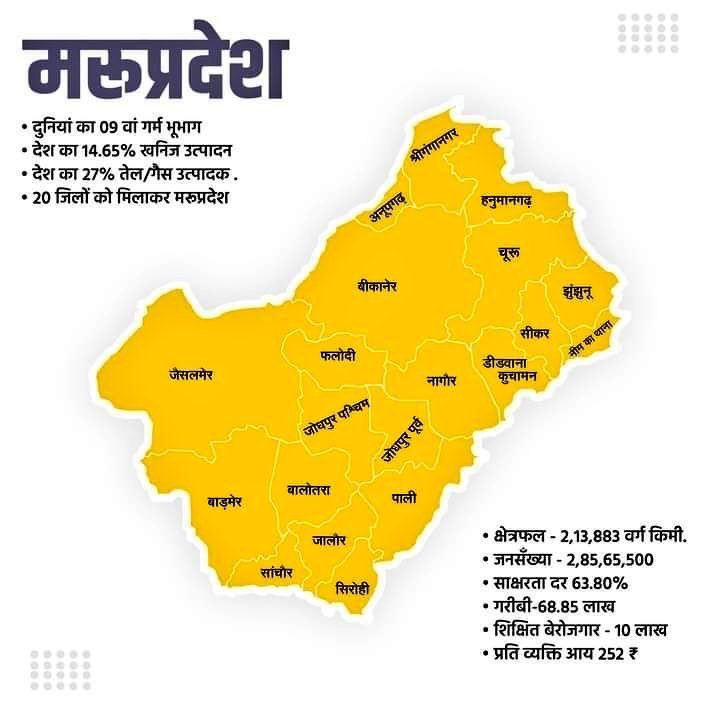
What is the concept of “Maru Pradesh”? I want more information about it.
What is Maru Pradesh?
Maru Pradesh is a proposed state in India that would be carved out from the state of Rajasthan. The name Maru Pradesh means “the land of the desert” in Hindi, as it covers the geographical, cultural, social, economic, political, and linguistic region of the Thar Desert in northwest India.
Why is there a demand for Maru Pradesh?
The demand for Maru Pradesh has been raised by some people living in the western districts of Rajasthan, who feel that they are neglected by the state government and lack proper development. They argue that the desert region has a distinct identity, history, and culture that is different from the rest of Rajasthan, and that it deserves more autonomy and resources to address its challenges and opportunities.
Some of the reasons for the demand for Maru Pradesh are:
- The desert region has a low per capita income, high poverty rate, and low human development index compared to the rest of Rajasthan.
- The desert region faces severe water scarcity, frequent droughts, and environmental degradation due to climate change and overexploitation of natural resources.
- The desert region has a large border area with Pakistan, which poses security and migration issues.
- The desert region has a diverse population that includes various ethnic, religious, and linguistic groups, such as Marwaris, Bagris, Punjabis, Shekhawatis, Hindus, Muslims, Sikhs, and Jains.
- The desert region has a rich cultural heritage that includes folk music, dance, art, literature, cuisine, and festivals, such as the Desert Festival, the Gangaur Festival, and the Teej Festival.
What are the challenges and prospects of Maru Pradesh?
The creation of Maru Pradesh would face several challenges and prospects, such as:
- The constitutional and legal process of creating a new state would require the consent of the Rajasthan state legislature, the Parliament of India, and the President of India, as well as the resolution of various administrative, financial, and territorial issues.
- The political and social opposition from the rest of Rajasthan, especially the eastern and southern districts, who may fear losing their political influence, economic resources, and cultural identity.
- The economic and developmental viability of Maru Pradesh, which would depend on its ability to generate revenue, attract investment, create employment, and provide public services, such as education, health, and infrastructure.
- The environmental and ecological sustainability of Maru Pradesh, which would require the adoption of innovative and adaptive strategies to conserve water, combat desertification, and promote renewable energy, such as solar and wind power.
- The social and cultural diversity of Maru Pradesh, which would require the promotion of harmony, tolerance, and inclusion among its various communities, as well as the preservation and promotion of its unique cultural heritage.
Which districts would be part of Maru Pradesh?
According to some sources, Maru Pradesh would consist of the following 21 districts that are located in the western part of Rajasthan:
District
Area (km2)
Population (2011)
Jalore
10,640
1,830,151
Barmer
28,387
2,603,751
Sanchore
4,561
451,735
Sirohi
5,136
1,036,346
Didwana Kuchaman
4,572
1,029,339
Hanumangarh
9,656
1,774,692
Jaisalmer
38,401
669,919
Bikaner
30,239
2,363,937
Jhunjhunu
5,928
2,139,658
Jodhpur
22,850
3,685,681
Jodhpur Rural
2,950
1,137,815
Nagaur
17,718
3,309,234
Pali
12,387
2,038,533
Phalodi
5,754
622,568
Anupgarh
2,741
629,279
Sikar
7,732
2,677,333
Neem ka Thana
1,758
499,379
Churu
13,835
2,041,172
Sri Ganganagar
11,154
1,969,168
Beawar
3,961
1,305,633
Total
213,887
28,132,949
The proposed capital of Maru Pradesh would be Jodhpur, the largest city and the second-largest district in the region. Jodhpur is also known as the “Blue City” or the “Sun City” for its distinctive blue-painted houses and sunny weather. Jodhpur is a major tourist destination and a cultural hub of Maru Pradesh, as it is home to several historical monuments, such as the Mehrangarh Fort, the Umaid Bhawan Palace, and the Jaswant Thada.
Nice Question, will be helpful for several people😊